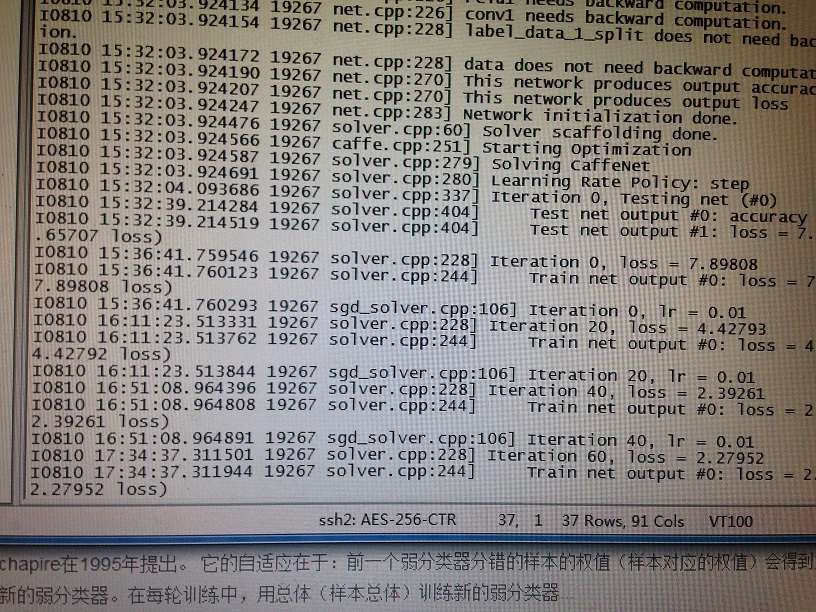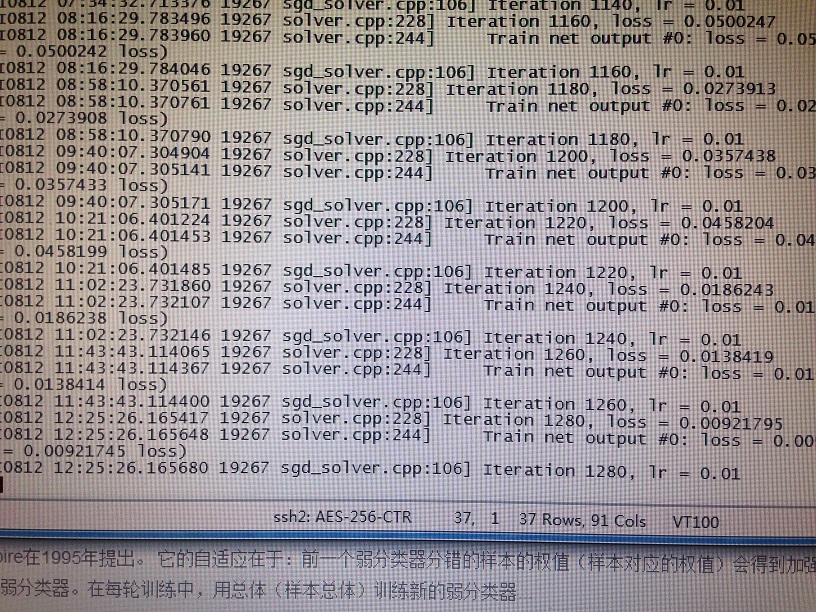注意:一下所有配置,均为林多的电脑配置路径。如果,要在自己的电脑上run,请仔细改为自己电脑上相应的路径。
1、准备训练数据
首先为训练数据和测试数据,新建两个文件夹,名称任意,存放数据:
trian(存放训练数据)
val(存放测试数据)
在tiran和val中,放入统一尺寸的图片,如320x320。保证这些图像的名称,不包含奇怪的字符。最好是数字或字母组成的名称。
2、新建train.txt和val.txt两个文本。
在train.txt中,输入train文件下的图片名+分类。
trian.txt内容如(更正:标签建议从0开始):
1.jpg 0
2.jpg 0
3.jpg 1
注意:1.jpg和1(类别)之间,只能有1个空格。
成千,上万的文件名,如何一下子输入到.txt中?
命令“dir/s/on/b>d:/train.txt”,可以将当前所在文件夹内的文件名(含路径,输入到tran.txt中),之后,只要利用记事本里的“查找—替换”功能,将路径名替换为空,将.jpg替换成(.jpg 1)。如存在多个分类,建立多个文件夹,将不同分类放入,重复上面步骤,最后将多个.txt内容整合到一个.txt中即可。
最后,将train.txt和val.txt放在与train和val文件夹同级的目录下。如D:/my文件夹内
注:在linux或windows下,跑caffe,其实差别不是很大,训练数据几乎是一样的,只是windows下多用leveldb格式,而linux下为默认的lmdb格式。至于配置文件,无非是指定路径的差别。
3、利用caffe自带例子中的imagenet来训练我们的数据。
windows下,将caffe安装目录下的examples\imagenet中的 create_imagenet.sh、make_ imagenet.sh、train_caffenet.sh。和models\bvlc_reference_caffenet中的solver.prototxt和train_val.prototxt。一共5个文件,拷入到D:/my文件夹中.
在windows下,安装Git,即可运行sh,十分方便。
4、生成leveldb和图像均值
修改create_imagenet.sh,内容如下:
#!/usr/bin/env sh
# Create the imagenet lmdb inputs
# N.B. set the path to the imagenet train + val data dirs
set -e
#对应自己的路径
DATA=D:/my
TOOLS=D:/caffe-master/Build/x64/Release
#对应自己的路径
TRAIN_DATA_ROOT=D:/my/train/
VAL_DATA_ROOT=D:/my/val/
# Set RESIZE=true to resize the images to 256x256. Leave as false if images have
# already been resized using another tool.
#改为true,让caffe为我们resize图片
RESIZE=true
if $RESIZE; then
RESIZE_HEIGHT=256
RESIZE_WIDTH=256
else
RESIZE_HEIGHT=0
RESIZE_WIDTH=0
fi
if [ ! -d "$TRAIN_DATA_ROOT" ]; then
echo "Error: TRAIN_DATA_ROOT is not a path to a directory: $TRAIN_DATA_ROOT"
echo "Set the TRAIN_DATA_ROOT variable in create_imagenet.sh to the path" \
"where the ImageNet training data is stored."
exit 1
fi
if [ ! -d "$VAL_DATA_ROOT" ]; then
echo "Error: VAL_DATA_ROOT is not a path to a directory: $VAL_DATA_ROOT"
echo "Set the VAL_DATA_ROOT variable in create_imagenet.sh to the path" \
"where the ImageNet validation data is stored."
exit 1
fi
echo "Creating train leveldb..."
GLOG_logtostderr=1 $TOOLS/convert_imageset \
--resize_height=$RESIZE_HEIGHT \
--resize_width=$RESIZE_WIDTH \
#指定数据格式
--backend=leveldb \
--shuffle \
$TRAIN_DATA_ROOT \
#对应自己的路径
$DATA/train.txt \
$DATA/imagenet_train_leveldb
echo "Creating val leveldb..."
GLOG_logtostderr=1 $TOOLS/convert_imageset \
--resize_height=$RESIZE_HEIGHT \
--resize_width=$RESIZE_WIDTH \
#指定数据格式
--backend=leveldb \
--shuffle \
$VAL_DATA_ROOT \
#对应自己的路径
$DATA/val.txt \
$DATA/imagenet_val_leveldb
echo "Done."
[图片]
运行后,生成imagenet_train_leveldb和imagenet_val_leveldb两个文件夹。
生成图像均值
修改make_imagenet_mean.sh,内容如下:
#!/usr/bin/env sh
# Compute the mean image from the imagenet training lmdb
# N.B. this is available in data/ilsvrc12
#对应自己的路径
DATA=D:/my
TOOLS=D:/caffe-master/Build/x64/Release
#对应自己的路径
$TOOLS/compute_image_mean.exe $DATA/imagenet_train_leveldb $DATA/imagenet_mean.binaryproto --backend=leveldb
echo "Done."
运行后,会生成imagenet_mean.binaryproto文件。
到此,数据阶段的所有内容,都已经准备好
5、配置,训练阶段需要的内容。
solver.prototxt内容:
#指定路径
net: "D:/my/train_val.prototxt"
test_iter: 1000
test_interval: 1000
base_lr: 0.01
lr_policy: "step"
gamma: 0.1
stepsize: 100000
display: 20
max_iter: 450000
momentum: 0.9
weight_decay: 0.0005
snapshot: 10000
#指定路径
snapshot_prefix: "D:/my/result"
#指定CPU训练
solver_mode: CPU
train_val.prototxt文件内容:
name: "CaffeNet"
layer {
name: "data"
type: "Data"
top: "data"
top: "label"
include {
phase: TRAIN
}
transform_param {
mirror: true
crop_size: 227
#指定路径
mean_file: "D:/my/imagenet_mean.binaryproto"
}
# mean pixel / channel-wise mean instead of mean image
# transform_param {
# crop_size: 227
# mean_value: 104
# mean_value: 117
# mean_value: 123
# mirror: true
# }
data_param {
#指定路径
source: "D:/my/imagenet_train_leveldb"
batch_size: 256
#指定格式
backend: LEVELDB
}
}
layer {
name: "data"
type: "Data"
top: "data"
top: "label"
include {
phase: TEST
}
transform_param {
mirror: false
crop_size: 227
#指定路径
mean_file: "D:/my/imagenet_mean.binaryproto"
}
# mean pixel / channel-wise mean instead of mean image
# transform_param {
# crop_size: 227
# mean_value: 104
# mean_value: 117
# mean_value: 123
# mirror: false
# }
data_param {
#指定路径
source: "D:/my/imagene_val_leveldb"
batch_size: 50
#指定格式
backend: LEVELDB
}
}
layer {
name: "conv1"
type: "Convolution"
bottom: "data"
top: "conv1"
param {
lr_mult: 1
decay_mult: 1
}
param {
lr_mult: 2
decay_mult: 0
}
convolution_param {
num_output: 96
kernel_size: 11
stride: 4
weight_filler {
type: "gaussian"
std: 0.01
}
bias_filler {
type: "constant"
value: 0
}
}
}
layer {
name: "relu1"
type: "ReLU"
bottom: "conv1"
top: "conv1"
}
layer {
name: "pool1"
type: "Pooling"
bottom: "conv1"
top: "pool1"
pooling_param {
pool: MAX
kernel_size: 3
stride: 2
}
}
layer {
name: "norm1"
type: "LRN"
bottom: "pool1"
top: "norm1"
lrn_param {
local_size: 5
alpha: 0.0001
beta: 0.75
}
}
layer {
name: "conv2"
type: "Convolution"
bottom: "norm1"
top: "conv2"
param {
lr_mult: 1
decay_mult: 1
}
param {
lr_mult: 2
decay_mult: 0
}
convolution_param {
num_output: 256
pad: 2
kernel_size: 5
group: 2
weight_filler {
type: "gaussian"
std: 0.01
}
bias_filler {
type: "constant"
value: 1
}
}
}
layer {
name: "relu2"
type: "ReLU"
bottom: "conv2"
top: "conv2"
}
layer {
name: "pool2"
type: "Pooling"
bottom: "conv2"
top: "pool2"
pooling_param {
pool: MAX
kernel_size: 3
stride: 2
}
}
layer {
name: "norm2"
type: "LRN"
bottom: "pool2"
top: "norm2"
lrn_param {
local_size: 5
alpha: 0.0001
beta: 0.75
}
}
layer {
name: "conv3"
type: "Convolution"
bottom: "norm2"
top: "conv3"
param {
lr_mult: 1
decay_mult: 1
}
param {
lr_mult: 2
decay_mult: 0
}
convolution_param {
num_output: 384
pad: 1
kernel_size: 3
weight_filler {
type: "gaussian"
std: 0.01
}
bias_filler {
type: "constant"
value: 0
}
}
}
layer {
name: "relu3"
type: "ReLU"
bottom: "conv3"
top: "conv3"
}
layer {
name: "conv4"
type: "Convolution"
bottom: "conv3"
top: "conv4"
param {
lr_mult: 1
decay_mult: 1
}
param {
lr_mult: 2
decay_mult: 0
}
convolution_param {
num_output: 384
pad: 1
kernel_size: 3
group: 2
weight_filler {
type: "gaussian"
std: 0.01
}
bias_filler {
type: "constant"
value: 1
}
}
}
layer {
name: "relu4"
type: "ReLU"
bottom: "conv4"
top: "conv4"
}
layer {
name: "conv5"
type: "Convolution"
bottom: "conv4"
top: "conv5"
param {
lr_mult: 1
decay_mult: 1
}
param {
lr_mult: 2
decay_mult: 0
}
convolution_param {
num_output: 256
pad: 1
kernel_size: 3
group: 2
weight_filler {
type: "gaussian"
std: 0.01
}
bias_filler {
type: "constant"
value: 1
}
}
}
layer {
name: "relu5"
type: "ReLU"
bottom: "conv5"
top: "conv5"
}
layer {
name: "pool5"
type: "Pooling"
bottom: "conv5"
top: "pool5"
pooling_param {
pool: MAX
kernel_size: 3
stride: 2
}
}
layer {
name: "fc6"
type: "InnerProduct"
bottom: "pool5"
top: "fc6"
param {
lr_mult: 1
decay_mult: 1
}
param {
lr_mult: 2
decay_mult: 0
}
inner_product_param {
num_output: 4096
weight_filler {
type: "gaussian"
std: 0.005
}
bias_filler {
type: "constant"
value: 1
}
}
}
layer {
name: "relu6"
type: "ReLU"
bottom: "fc6"
top: "fc6"
}
layer {
name: "drop6"
type: "Dropout"
bottom: "fc6"
top: "fc6"
dropout_param {
dropout_ratio: 0.5
}
}
layer {
name: "fc7"
type: "InnerProduct"
bottom: "fc6"
top: "fc7"
param {
lr_mult: 1
decay_mult: 1
}
param {
lr_mult: 2
decay_mult: 0
}
inner_product_param {
num_output: 4096
weight_filler {
type: "gaussian"
std: 0.005
}
bias_filler {
type: "constant"
value: 1
}
}
}
layer {
name: "relu7"
type: "ReLU"
bottom: "fc7"
top: "fc7"
}
layer {
name: "drop7"
type: "Dropout"
bottom: "fc7"
top: "fc7"
dropout_param {
dropout_ratio: 0.5
}
}
layer {
name: "fc8"
type: "InnerProduct"
bottom: "fc7"
top: "fc8"
param {
lr_mult: 1
decay_mult: 1
}
param {
lr_mult: 2
decay_mult: 0
}
inner_product_param {
num_output: “类别数”#注意,此处对应训练数据的标签数(如100个类别:100)
weight_filler {
type: "gaussian"
std: 0.01
}
bias_filler {
type: "constant"
value: 0
}
}
}
layer {
name: "accuracy"
type: "Accuracy"
bottom: "fc8"
bottom: "label"
top: "accuracy"
include {
phase: TEST
}
}
layer {
name: "loss"
type: "SoftmaxWithLoss"
bottom: "fc8"
bottom: "label"
top: "loss"
}
将train_caffenet.sh,改为train_caffenet.bat,内容如下:
#!/usr/bin/env sh
set -e
#指定路径
D:/caffe-master/Build/x64/Release/caffe.exe train --solver=D:/my/solver.prototxt
到此,运行train_caffenet.bat,训练网络即可。。当然,你可以不把train_caffenet.sh改为.bat文件,只需要修改里面的路径后,在Git中,运行即可。
5、linux下
PS:博主某天重新看了下这段,有些乱。于是这段的仅供参考(-_-)
首选保证,你以及配置好caffe了。
在windows下,你也可以在linux下这么做。。将数据重新生成lmdb格式。。。就是在上面的步骤中,去掉 --backend=leveldb \,再将 $DATA/imagenet_train_leveldb 改为 $DATA/imagenet_train_lmdb (val的也要改)
这样会生成imagenet_train_lmdb和imagenet_val_lmdb两个文件夹。将生成的imagenet_train_lmdb和imagenet_val_lmdb两个文件夹中的内容,上传到linux服务器中。
首先,在~/caffe/examples/imagenet(以我安装caffe路径为例)文件夹下,利用mkdir命令新建两个文件夹
ilsvrc12_val_lmdb和ilsvrc12_train_lmdb。。将imagenet_train_leveldb和imagenet_val_leveldb中的内容,在SecureCRT中利用rz命令上传文件(将train文件夹中的图片,传入imagenet_train_leveldb。将val中的图片,传入imagenet_val_leveldb)
make_imagenet_mean.sh (无需修改)
create_imagenet.sh(无需修改)
train_caffenet.sh内容(无需修改)
solver.prototxt内容(无需修改默认)
train_val.prototxt内容:(无需修改,默认)
之后,切换到~/caffe目录下
按照windows下的流程,运行 make_imagenet_mean.sh,然后train_caffen.sh。
如果,出现如法运行的情况,请切换到caffe安装根目录(~/caffe),在该目录下运行sh。
实际训练效果非常慢,大约1小时才回蹦出下一条提示。估计是Net的结构配置的不对,毕竟用了自己的数据,Net结构肯定要修改。但训练效果还是很好的。
下面是在linux服务器上跑的结果。
跑了大概两天,loss从最开始的7.65707,迭代到1280次时,降到0.000921745。训练出来的模型完全可以利用caffe+opencv做分类了~
这里提供了图片数据、标签分类文本、还是网络配置数据。在运行前,要生成自己的leveldb嗷~
Windows下caffe训练实例

























 1万+
1万+

 被折叠的 条评论
为什么被折叠?
被折叠的 条评论
为什么被折叠?










